The Scottish Fold is a unique and charming breed known for its distinctive folded ears, which give it a round, owl-like appearance. Originating in Scotland, these cats have a medium build with a sturdy body and a rounded head. Their eyes are large and expressive, often in shades of gold or copper. Scottish Folds are typically friendly, affectionate, and adaptable, making them great companions for families and individuals alike. They enjoy social interaction but are also known for their calm and easygoing nature, often forming strong bonds with their owners.
Author: admin
-
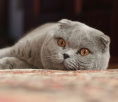
The Scottish Fold
-
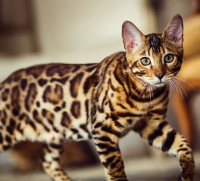
Bengal Cat
The Bengal cat is a striking breed known for its distinctive spotted or marbled coat that resembles that of a wild leopard. Originating from a cross between domestic cats and the Asian leopard cat, Bengals are medium to large in size and have a muscular build. They are highly energetic, playful, and intelligent, often enjoying interactive play and puzzle toys. Bengals are social and tend to bond closely with their owners, making them affectionate companions. Their curious nature and love for climbing and exploring also require a stimulating environment to keep them happy and engaged.
-
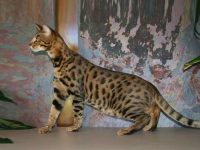
Savannah Cat
The Savannah cat is a striking and exotic breed, created by crossing a domestic cat with a serval, a wild African cat. Known for their tall, slender bodies, large ears, and distinctive spotted coat, Savannahs exhibit a unique blend of domestic and wild characteristics. They are highly energetic, playful, and intelligent, often displaying dog-like behaviors such as fetching and walking on a leash. Savannah cats are social and enjoy interacting with their owners, making them engaging companions. Their size can vary, with some individuals reaching up to 20 inches tall, depending on their generation.
-
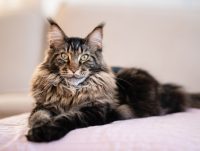
Maine Coon
The Maine Coon is a large, friendly, and sociable cat breed known for its luxurious, thick fur, bushy tail, and tufted ears. Originating from the northeastern U.S., these cats are often called “gentle giants” due to their affectionate and easygoing nature. Despite their size, Maine Coons are playful and curious, enjoying interaction with people and other pets. Their coats, which come in various colors and patterns, are water-resistant and help them adapt to colder climates. Maine Coons are intelligent, loyal, and make great companions, often following their owners around the house.
-

The British Shorthair
The British Shorthair is a sturdy, medium-to-large cat known for its round face, dense coat, and calm demeanor. Their plush fur, often seen in the iconic “British Blue” color, comes in a variety of other shades and patterns. With large, round eyes (usually copper or gold), these cats have a gentle, easygoing personality. British Shorthairs are affectionate but not overly demanding, making them ideal companions for families or individuals seeking a laid-back, independent cat that enjoys affection on its own terms. They are also known for their loyalty and quiet intelligence.
-
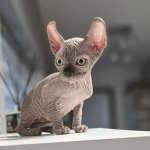
Sphynx
The Sphynx cat is a distinctive and unusual breed, instantly recognizable due to its hairless appearance, large ears, and wrinkled skin. Despite their lack of fur, Sphynx cats are known for their warmth—both in body temperature and personality. These affectionate, playful, and social cats have become popular companions, often forming deep bonds with their human families.
Physical Appearance
The Sphynx cat’s most striking feature is its lack of fur, though they are not entirely bald. Many Sphynx cats have a fine layer of peach-fuzz-like down, which gives their skin a soft texture. Their skin comes in a variety of colors and patterns, similar to furred cats, including solid, tabby, and tortoiseshell.
Other key physical characteristics include their:
- Wrinkled skin, especially around the face, neck, and shoulders.
- Large, bat-like ears, which give them an alert and expressive look.
- Almond-shaped eyes, which are typically wide and expressive.
- Muscular, medium-sized body, which is surprisingly strong and agile.
Their bodies are often warm to the touch, as they compensate for the lack of insulating fur by having a slightly higher body temperature than most cats.
Personality and Behavior
Sphynx cats are known for their extroverted and affectionate nature. They thrive on human attention and tend to follow their owners around the house, seeking companionship. These cats are curious, energetic, and playful, often described as dog-like in their loyalty and desire for interaction.
They are also highly social and do well in homes with other pets or children, enjoying the company and stimulation of others. Sphynx cats are often the center of attention, not only because of their unique appearance but also due to their fun-loving and sometimes mischievous personalities. They are known to be intelligent and enjoy playing with interactive toys, climbing, and exploring their surroundings.
Care Requirements
- Skin Care: Unlike furred cats, Sphynx cats need regular skin care. Their skin produces natural oils that are usually absorbed by fur, but since they lack a coat, these oils can build up on the skin. Regular baths (usually once a week) are needed to keep their skin clean and free from excess oil.
- Sun Protection: Sphynx cats are sensitive to sunlight and can get sunburned if exposed for too long. It’s important to keep them indoors or ensure they have proper shade when outside.
- Temperature Sensitivity: Without fur, Sphynx cats can easily get cold, so they may seek out warm spots like sunny windows, blankets, or even their owner’s lap. Many Sphynx cats enjoy wearing sweaters or blankets to stay cozy in cooler weather.
- Diet: A balanced, high-quality diet is essential to maintain their health. Due to their higher metabolism, Sphynx cats may require slightly more food than other cats to maintain their body temperature.
- Ears and Nails: Their large ears can accumulate wax more quickly than other breeds, so they need regular ear cleaning. Their nails also need to be trimmed regularly.
Health Considerations
The Sphynx cat is generally a healthy breed, but they can be prone to certain conditions, including:
- Hypertrophic Cardiomyopathy (HCM): A heart condition that affects the thickness of the heart muscle, which is relatively common in the breed.
- Skin Issues: Some Sphynx cats may be prone to skin infections or acne, particularly if their skin isn’t cleaned regularly.
Routine veterinary care and health screenings are essential to catch any potential health issues early.
Conclusion
Sphynx cats are a unique and loving breed, known for their hairless bodies and warm, affectionate personalities. They require more grooming and care than other breeds due to their lack of fur, but their playful, social nature makes them wonderful companions. With proper care and attention, Sphynx cats can bring endless joy and entertainment to their households.
-
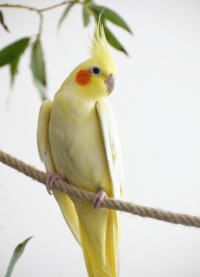
Cockatiels
Introduction
The cockatiel (Nymphicus hollandicus) is one of the most popular pet birds in the world, cherished for its charming personality, attractive crest, and friendly demeanor. Native to Australia, cockatiels are members of the cockatoo family and are the smallest of this group. They are known for their whistling abilities, playful antics, and affectionate nature, making them a favorite among bird enthusiasts and families alike.
Physical Appearance
Cockatiels are medium-sized parrots, typically measuring about 30-33 cm (12-13 inches) in length from beak to tail. Their most distinctive feature is the crest on top of their heads, which rises and falls depending on their mood. A relaxed, flattened crest indicates a calm bird, while an upright crest shows excitement or curiosity.
The wild-type cockatiel has a grey body, with a yellow face and bright orange cheek patches, but there are many color mutations available, including pied, lutino (yellow), albino, pearl, and cinnamon. These variations have made cockatiels even more popular as pets, with each bird displaying its own unique coloring and markings.
Behavior and Personality
Cockatiels are known for their friendly and social nature. They are naturally curious and enjoy interacting with their human caregivers. Unlike some larger parrots, cockatiels are generally easier to handle and less demanding, making them a great choice for both novice and experienced bird owners.
One of their endearing traits is their ability to mimic sounds and whistles. While they are not as gifted as some parrots in mimicking human speech, they can learn to whistle tunes and often imitate household noises like doorbells or telephones. Males are typically better at whistling and mimicking sounds than females.
Their vocalizations are pleasant and not as loud as those of larger parrots, making them suitable for apartment living. They often engage in soft chattering, and their whistling can be quite melodious.
Care Requirements
Cockatiels are relatively easy to care for compared to other parrots, but they still require attention and proper care to stay healthy and happy.
- Cage Size: Cockatiels need a spacious cage to stretch their wings and move around comfortably. A minimum of 24×24 inches is recommended for one bird, but the larger the cage, the better. Make sure the bar spacing is appropriate to prevent escape or injury (around 1/2 inch spacing is ideal).
- Diet: A balanced diet is essential for a cockatiel’s health. Their diet should consist of high-quality pellets, seeds, fresh fruits, and vegetables. Seeds should not be the main component of their diet, as this can lead to nutritional deficiencies. Vegetables like leafy greens, carrots, and sweet potatoes are great for them, as well as fruits like apples and berries in moderation.
- Social Interaction: Cockatiels are social birds and need regular interaction with their owners. They enjoy being handled, whistled to, and engaged with toys. Without enough socialization and mental stimulation, cockatiels can become bored or depressed, leading to undesirable behaviors like feather plucking.
- Exercise: Allowing your cockatiel time outside of the cage to fly or explore in a bird-safe environment is important for their physical and mental well-being. Daily out-of-cage time ensures they stay healthy and active.
- Toys and Enrichment: Cockatiels enjoy toys that they can chew, shred, and interact with. Toys made from natural materials like wood, paper, and leather are ideal. They also love mirrors, bells, and puzzle toys that challenge their intelligence.
- Grooming: Regular grooming is necessary for a cockatiel’s health. They enjoy bathing and should have access to water for bathing or be misted with a spray bottle. Their nails may also need to be trimmed if they don’t naturally wear down.
Lifespan and Health
Cockatiels have a relatively long lifespan, typically living between 15-20 years with proper care, and some can live even longer. To ensure a long and healthy life, regular vet check-ups are recommended, along with a varied and nutritious diet. Common health issues include respiratory infections, feather plucking (often due to stress or boredom), and nutritional deficiencies, so it’s important to be attentive to any changes in behavior or appearance.
Cockatiel Communication
Cockatiels use their crest and body language to communicate their mood. An upright, fully raised crest indicates curiosity or excitement, while a flattened crest can show that the bird is relaxed or, conversely, feeling defensive if paired with hissing. Fluffed-up feathers generally indicate contentment, but if combined with lethargy, it could be a sign of illness.
Breeding and Reproduction
Cockatiels are relatively easy to breed in captivity. They are cavity nesters, meaning they lay their eggs in enclosed spaces like tree hollows in the wild, or in nest boxes when kept in captivity. Females typically lay between 4-6 eggs, and both parents take turns incubating them for about 18-21 days until they hatch. Baby cockatiels, or chicks, are born with sparse down feathers and are dependent on their parents for food and warmth until they fledge (leave the nest) at around 4-5 weeks of age.
Conclusion
Cockatiels make excellent pets for people of all ages due to their friendly nature, manageable size, and relatively easy care requirements. Their playful personalities, coupled with their ability to form strong bonds with their owners, make them delightful companions. With proper care, a balanced diet, and plenty of social interaction, a cockatiel can bring years of joy and companionship to any household.
-
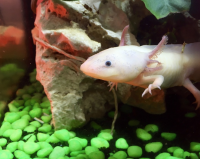
Axolotl Care Guide
- Tank Size: Minimum 60cm (2 feet) for one axolotl.
- Water Temperature: 16-18°C; avoid temperatures above 20°C.
- Filtration: Gentle filter; avoid strong currents.
- Water Quality: Dechlorinated, with ammonia and nitrite at 0. Regular water tests.
- Substrate: Sand or bare-bottom; avoid gravel (risk of impaction).
- Diet: Earthworms, bloodworms, or axolotl pellets; avoid large or hard foods.
- Lighting: Low light; axolotls prefer dim environments.
- Handling: Minimal; they are delicate and sensitive to stress.
- Tank Mates: Best kept alone; avoid aggressive fish or species that may nip.
Regular maintenance ensures a healthy axolotl!
-

Rana Temporaria
Introduction
Rana temporaria, commonly known as the common frog or European common frog, is one of the most widespread amphibians in Europe. Known for its adaptability, it thrives in a range of habitats, from damp woodlands to urban gardens. Unlike some of its more tropical cousins, Rana temporaria is particularly well-suited to colder climates, including regions like the British Isles, Scandinavia, and parts of Russia. Its distinctive appearance and fascinating life cycle make it an important species for understanding the ecology of European amphibians.
Physical Description
The common frog has a stocky body, with a head that is broad and flattened. Its coloration varies widely, usually ranging from olive-green or brown to more vivid shades of red or yellow. This variation helps with camouflage in different environments, whether the frog is in a dense forest or an open field. The skin is generally smooth and moist, with darker markings and spots often found on its back, particularly behind the eyes.
A hallmark of Rana temporaria is the dark “mask” or patch located behind its eyes, which extends down toward the tympanum (eardrum). The underside is lighter, often yellowish or white with darker speckles. Adults typically reach between 6 to 9 cm (2.4 to 3.5 inches) in length, although females tend to be larger than males, especially during the breeding season.
Habitat and Distribution
Rana temporaria is highly adaptable and can be found in a wide range of habitats across Europe and parts of Asia. Its range stretches from western Europe, including the UK and Ireland, all the way to eastern Russia and Siberia. It is often found in forests, meadows, wetlands, and even urban areas like gardens and parks.
This species is particularly notable for its ability to thrive in cooler climates. Unlike many other frogs that prefer tropical or subtropical environments, Rana temporaria can survive in regions where temperatures frequently drop below freezing. It can even be found at high altitudes in mountainous regions such as the Alps and the Pyrenees.
During the colder months, Rana temporaria hibernates, either in mud at the bottom of ponds or beneath leaf litter and logs in terrestrial environments. Its ability to survive hibernation under ice is an adaptation to living in such cold climates, as it slows down its metabolism and absorbs oxygen through its skin.
Breeding and Reproduction
Breeding is one of the most distinctive aspects of the common frog’s life cycle. In early spring, usually between March and May, Rana temporaria returns to ponds, lakes, or slow-moving streams to reproduce. Males arrive at the breeding sites first and use croaking calls to attract females. They often form dense breeding aggregations in shallow water.
During mating, the male clasps the female in a position called amplexus, which is common in many frog species. He fertilizes the eggs externally as the female lays them. A single female can lay up to 2,000 to 3,000 eggs, which are deposited in large clumps called frogspawn. These clumps are often visible floating at the surface of ponds and are an iconic symbol of spring in many parts of Europe.
The eggs hatch within a few weeks, depending on water temperature, and the tadpoles emerge. Tadpoles undergo a metamorphosis over the course of several months, developing from aquatic, gilled larvae into air-breathing, land-dwelling juvenile frogs. By late summer, the young frogs leave the water to start their terrestrial phase of life.
Diet and Behavior
As an opportunistic feeder, Rana temporaria consumes a wide variety of prey. Its diet mainly consists of insects, spiders, slugs, snails, and other small invertebrates. As tadpoles, they are herbivorous or omnivorous, feeding on algae and detritus in their aquatic environment. However, once they metamorphose into frogs, they become strictly carnivorous.
The common frog is largely nocturnal and spends much of its time hiding in damp, sheltered places during the day. It relies on its camouflage to avoid predators, which include birds, mammals, and reptiles. Despite their somewhat sluggish appearance on land, they are excellent swimmers and can move quickly through water to escape danger.
Conservation Status
Rana temporaria is listed as a species of “Least Concern” by the International Union for Conservation of Nature (IUCN), which means it is not currently facing a significant risk of extinction. However, like many amphibians, it faces challenges from habitat destruction, pollution, and the spread of diseases such as chytridiomycosis.
In some areas, populations have declined due to urbanization, agriculture, and the draining of wetlands. Climate change also poses a potential threat, as shifts in temperature and rainfall patterns could disrupt breeding cycles and reduce the availability of suitable habitats. Despite these pressures, the common frog remains one of Europe’s most resilient amphibians, thanks to its wide range and adaptability.
Conclusion
The common frog, Rana temporaria, is a remarkable amphibian that plays a vital role in European ecosystems. Its adaptability to various climates, including cold regions, and its wide distribution make it one of the most successful frog species in Europe. From its iconic breeding behavior in spring to its vital role in controlling insect populations, Rana temporaria is an important and fascinating species that continues to thrive across its vast range, even in the face of environmental challenges.
-
Dendrobates: The Jewel-Like Poison Dart Frogs
Introduction
Dendrobates, a genus within the family Dendrobatidae, are small, brightly colored frogs that are often referred to as poison dart frogs. Native to the tropical rainforests of Central and South America, these frogs are famous for their vivid colors and potent toxins. Despite their tiny size, Dendrobates have captivated scientists, conservationists, and frog enthusiasts alike due to their unique adaptations and the complex interplay between their biology, ecology, and evolution.
A Splash of Color
One of the most striking features of Dendrobates is their intense, almost neon coloration. These frogs can be blue, green, red, yellow, or even multicolored, with intricate patterns that make them look like living jewels. This coloration serves an important evolutionary purpose known as aposematism — a warning to potential predators. The bright colors signal that the frogs are toxic and dangerous to eat. Predators quickly learn to associate these colors with a bad taste or even the risk of death, leaving the frogs relatively safe despite their small size.
Toxicity: Nature’s Defense Mechanism
The toxicity of Dendrobates species varies greatly between different frogs. The toxins, known as batrachotoxins, are alkaloid compounds that the frogs acquire through their diet, mainly from consuming certain ants, mites, and other small invertebrates that carry the necessary chemicals. In their natural habitats, the poison can cause paralysis or death in predators. Indigenous tribes in some regions have historically used the frog’s skin toxins to poison blow darts, which is how the frogs earned the name “poison dart frogs.”
However, not all Dendrobates are equally toxic. For example, species like Dendrobates tinctorius, one of the most common species in the pet trade, are less toxic than the highly poisonous Phyllobates terribilis, which isn’t technically part of the Dendrobates genus but belongs to the same family. In captivity, where these frogs don’t consume their natural prey, their toxicity diminishes significantly, making them harmless to humans.
Behavior and Habitat
Dendrobates frogs are generally diurnal, meaning they are active during the day, and they are known for their territorial behavior. Males call to establish dominance and attract mates, and their vocalizations vary between species. The calls are often rapid and high-pitched, sounding more like insect noises than traditional frog calls.
These frogs typically live in the humid lowland forests of countries like Brazil, Colombia, and Costa Rica, although some species can be found in higher-altitude cloud forests. They prefer areas with plenty of leaf litter and dense plant cover, which offer protection and ample food. Despite their toxic defenses, they are vulnerable to habitat loss due to deforestation and agricultural expansion.
Reproduction and Parental Care
Dendrobates exhibit fascinating parental care, which is relatively rare in amphibians. After mating, females lay their eggs in moist areas like under leaves or on moss. Males then guard the eggs and keep them hydrated by urinating on them. Once the tadpoles hatch, one of the parents (usually the male) will carry the tadpoles on their back to small pools of water, often inside bromeliads or other plants that collect rainwater.
Some species, like Dendrobates pumilio, even exhibit biparental care, where both parents are involved. Females of this species will deposit unfertilized eggs into the water pools as a food source for their growing tadpoles, a behavior known as trophic egg feeding. This high level of parental investment increases the survival rate of their offspring.
Species Diversity
There are numerous species within the Dendrobates genus, each with its own unique characteristics. A few notable species include:
- Dendrobates tinctorius: Known as the dyeing dart frog, it is highly variable in color and pattern. It’s one of the larger species and often less toxic compared to others in the family.
- Dendrobates auratus: Commonly called the green and black poison dart frog, it is widespread in Central America and is known for its striking black and green patterns.
- Dendrobates leucomelas: The yellow-banded poison dart frog, native to Venezuela, is easily recognizable due to its bright yellow and black bands. It is also popular in the pet trade.
Conservation Status
Many species of Dendrobates are under threat due to habitat destruction, climate change, and pollution. As rainforests continue to shrink, the ecosystems that these frogs depend on are rapidly disappearing. In addition, the illegal pet trade has also contributed to their decline, although breeding programs in captivity have reduced the need for wild-caught specimens.
Conservation efforts focus on habitat preservation, legal protections, and public education. Some species are listed as endangered or critically endangered by the International Union for Conservation of Nature (IUCN), which highlights the need for continued conservation initiatives.
Frogs in Captivity: The Pet Trade
Dendrobates species are popular in the exotic pet trade due to their stunning appearance and interesting behaviors. Captive-bred frogs are non-toxic, making them safe for handling, though they are still delicate and require specific care. Maintaining a proper vivarium with high humidity, tropical plants, and small insects for food is essential to keep these frogs healthy.
Breeding Dendrobates in captivity has also contributed to their conservation by reducing the need for wild specimens, although it’s important to ensure that pet owners are purchasing frogs from reputable breeders.
Conclusion
Dendrobates frogs are a remarkable example of nature’s beauty and ingenuity. With their dazzling colors, potent toxins, and intricate behaviors, they have earned their place as one of the most fascinating groups of amphibians on the planet. While they face significant threats in the wild, ongoing conservation efforts and responsible pet ownership offer hope for their continued survival. These “living jewels” of the rainforest remind us of the delicate balance of ecosystems and the importance of preserving biodiversity for future generations.